Modern Mazdas strike me as constantly grinning things, with their big, smile-shaped grilles and squinty headlights. I know this is part of Mazda’s Kodo – Soul of Motion design language, but still.
It’s not like these vehicles shouldn’t be happy. One in particular ought to be celebrating awards like February’s AJAC Utility Vehicle of the Year and AJAC SUV/CUV of the Year (under $35,000).
Take a bow, Mazda CX-3. And keep smiling.
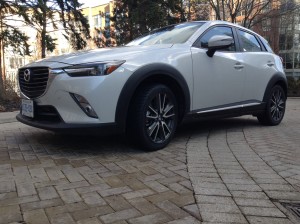
First impressions
The Ceramic Metallic paint job was the only white I saw much of during my week with the Mazda CX-3 at the beginning of a Toronto February. And that was fine with me.
Mazda makes the most of the vehicle’s height, maximizing the “mouth” of the grille, one of the more obvious elements of Mazda’s Kodo Soul of Motion design language. The CX-3 owes much of its attractiveness to great curves like the one that flows gently up from the outside corners of the headlights to just below the door glass, then slopes down to the tops of the rear wheel wells.
It also convinced me it was larger than it actually turned out to be. Maybe that’s because the body style is so close to big brother CX-5 that I half-expected to step “up” to the drivers seat, but entering and exiting was a very carlike experience given how close the CX-3 is in size to its sibling Mazda3.
(The CX-3’s size is a matter I pondered for a while. Thinking back, we had cars and trucks. Then SUVs lumbered onto the scene. In the ’90s, carmakers sprang mini-SUVs – aka crossovers – onto the market. Now we have compact crossovers, vehicles that resemble SUVs in body style but are little bigger than passenger cars. Ongoing segmentation seems to be a big part of automotive evolution.)
Interior
Leather and Lux Suede® trimmed upholstery greet the driver upon entry. Subtly elegant touches include the burgundy accents on the doors and center stack, and red stitching on leather elements like the shift knob and handbrake lever.
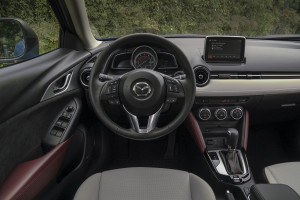
photo courtesy Mazda
The power moonroof doesn’t interfere with headroom – the CX-3 is sufficiently tall to fit me. Quick work on the three manual adjustments on the seat and one for the leather-wrapped steering wheel was all it took to get comfortable.
The hockey bag fit – just – without my having to lower the rear seats. My bag kept the solid privacy cover from sitting in its usual place, so it blocked a good portion of my rear view. Note to self – take privacy cover off when traveling in CX-3 with hockey bag in back.
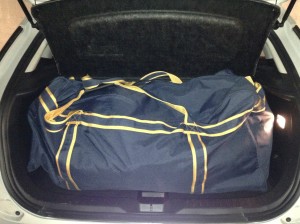
In-car technology
Mazda keeps things simple with its combination of HMI Commander and 7” dash-mounted touchscreen, the input and output of Mazda Connect.
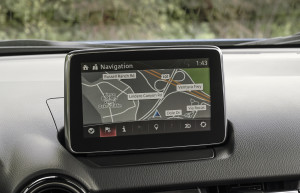
photo courtesy Mazda
Scrolling, “joysticking” and clicking through the straightforward menu layout using the HMI Commander leads quickly to whatever options the driver wants to use. Five buttons and a volume knob complete this no-look control cluster. Mazda adds a little “bump” just behind the volume knob where drivers can rest their palms as they use the HMI Commander.
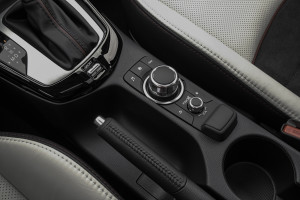
photo courtesy Mazda
I found this cluster made reaching for the screen mostly unnecessary, although touching the screen makes it easier to dial a number or enter an address into the navigation system. Coupled with the attractive and intuitive design of on-screen graphics (extra marks for the radio dials), the total package is both easy on the eyes and easy to learn.
Thankfully, Mazda knows to make certain frequently-used controls available in more traditional ways. For instance, climate controls consist of three dials, each of which is also a button. Heated seats are activated using buttons.
Power up the car and the Active Driving Display pops up above the instrument cluster. The ADD (what an unfortunate acronym) is a small piece of clear glass onto which the Mazda projects information like speed, the lane departure system, radar cruise control and other driving systems.
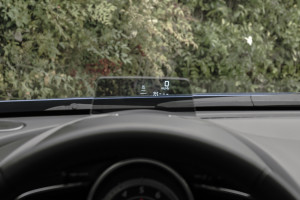
photo courtesy Mazda
This isn’t quite a heads-up display, but kudos to Mazda for helping drivers keep their heads up. Putting infotainment and instrument displays higher, i.e. closer to where drivers ought to keep their eyes, means drivers need not take their eyes off the road as much.
This screen has to be adjusted so drivers of different heights can see the information projected there. Drivers do the adjusting using Settings via Mazda Connect, not by manipulating the screen with their hands. This isn’t obvious. I learned this by skimming through the manual (the technical writer in me obliges me to check out manuals for everything), and drivers might stumble across the feature if they browse the Settings menu. I presume Mazda dealers help CX-3 buyers set up this screen before driving the car off the lot. Otherwise, I could see quite a few of these screens being broken.
Ordinarily, I wouldn’t mention the absence of power seat adjustments and memory settings for different drivers, but the need to adjust the seat, three mirrors AND this display after somebody else drives the CX-3 makes driver position memory settings a great idea in this vehicle.
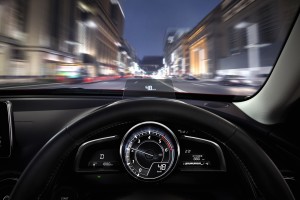
photo courtesy Mazda
Driving
Peak horsepower and torque from Mazda’s 2.0L SKYACTIV engine both hit 146.
Power reaches the wheels through a six-speed automatic. Mazda includes a manual mode and steering-wheel-mounted paddle shifters. If Mazda’s media site photos are anything to go by, somewhere in the world people can enjoy the CX-3 with a proper stick shift. Mazda’s Canadian website dashes that hope for us Canadians. (I’ve been told by more than one “car person” that I’m a dying breed, but I enjoyed driving the Mazda3 and Mazda6 equipped with 6-speed manual transmissions, so I feel compelled to note this omission.)
The CX-3 is zippy enough for everyday driving. Mazda includes a Sport Mode switch that drivers can push forward to get a little more oomph out of the car. After having the car flash lousy fuel economy numbers at me for a little while, I clicked the right paddle shifter to lower engine revs on the highway. Then I remembered to simply switch the CX-3 out of Sport Mode.
One thing I don’t test on vehicles is the collision avoidance system – at least not on purpose. The CX-3 changed that for me. While I slowly approached a rising gate arm, the CX-3 “stuttered” the brakes, flashed a red icon on the instrument cluster and sent a message including the words “Smart City Brake Support” (SCBS) to the Active Driving Display to let me know an obstacle “lay” ahead.
I guess I was approaching the rising gate arm a little too quickly for Mazda’s SCBS system. The manual states SCBS ought to help people avoid collisions if they’re traveling at less than 20 kph faster than the vehicle ahead of them.
SCBS is just one of the active safety technologies bundled in the CX-3 under the i-ACTIVSENSE umbrella. Many of these features make use of the Mazda’s Forward Sensing Camera, laser, and various radar sensors front and rear to help keep drivers out of hot water or, if it’s too late for that, to mitigate any collisions that do happen.
In GT trim, Mazda adds a Blind Spot Monitoring system, a Rear Cross Traffic Alert (for those outings to mall parking lots), a Lane Departure Warning System, and, of course, Smart City Brake Support.
Fuel economy
Mazda publishes 8.8 city/7.3 highway numbers for my AWD tester. FWD models get 8.2 and 6.7, respectively. The CX-3 takes regular unleaded in its 45-litre tank (48 litres in front-wheel-drive models).
Pricing
The CX-3 in GT trim that I drove starts at $28,995 MSRP. Taxes and options, including the $1,500 Technology Package, brought the MSRP to $32,590.
Mazda offers two more economical trim levels. The GX starts at $20,695 MSRP, while the GS can be had for $22,695 MSRP.